I drew together a couple of unrelated aspects of science into an activity about butterflies which my son enjoyed. It built upon our recent visit to the butterfly house at the Horniman museum, but I also drew heavily on the Hungry Caterpillar story by Eric Carle.
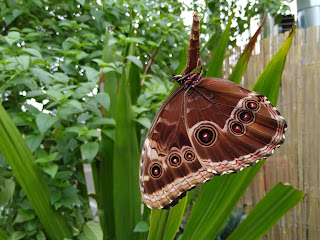 |
| Butterfly at the Horniman museum |
At the butterfly house, my sons saw several species of caterpillars and butterflies, we found a butterfly egg on a leaf and we looked at some butterflies emerging from pupae. We talked on the way home about the butterfly life cycle as he'd been really excited about the
frog life cycle. I thought I'd add some pictures of the butterfly life cycle to his collection and see what he made of them. I also wanted to try out some salt drawings to try and get him interested in painting, so I decided to theme this around the butterfly life cycle and give him the counters alongside making the pictures.
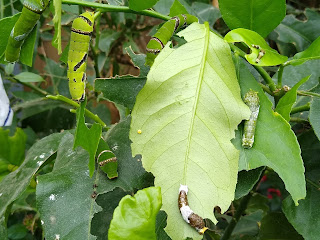 |
| Yellow egg and three species of caterpillar |
The science of the salt drawings is that table salt (sodium chloride) absorbs water. You stick salt to paper with PVA glue and let it dry. Then when you touch coloured liquid to the salt, it is rapidly absorbed and the colours spread out along the glued salt but leave the rest of the paper untouched. For a boy who doesn't much like drawing or painting, I thought this may be both a bit of interesting science and a way to help him create some nice pictures without needing much skill.
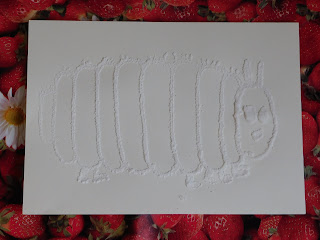 |
| Salt drawing of the hungry caterpillar |
With PVA glue in a bottle with a narrow nozzle, I drew some pictures of an egg on a leaf, a caterpillar, a pupa and a butterfly, based on Eric Carle's illustrations. I shook salt over these and then tilted them in several directions on a tray to get as much salt stuck to the glue as possible. I then let them dry overnight.
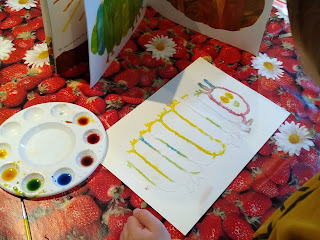 |
| Salt painting |
The small boy was curious about what they were, and I made up some very concentrated food colouring (approximately 1:4 dilution) for him to use as paint. You could also use liquid watercolours or dissolve solid watercolour blocks in water instead.
I got him to try touching the brush into the 'paint' and then on the salt and he liked the way the colour spread along the line. I put the Hungry Caterpillar book open in front of him to give him some ideas about which colours he might like to use as he doesn't seem to like painting a blank canvas and deciding what to draw and which colour to use.
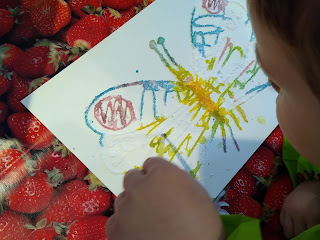 |
| Butterfly painting |
He wanted to give up after a couple of minutes but I asked him to try painting a 'junction' between two lines instead and he was amazed to see the colour travelling along the lines that intersected the one he touched. He then decided it was actually fun and he could pretend to be a paint train colouring the tracks, and he set about filling in all the lines on all 4 of the pictures I made! He also had fun experimenting with colour mixing, both in the palette and by watching adjacent colours mix along the salt lines. He kept going for about 20 minutes which is definitely the longest time he's ever done any painting!
 |
| Complete life cycle |
At the end, he had the four stages of the butterfly life cycle and we laid them out and talked through the stages using the narrative of the book, referring also to what we'd seen in the butterfly house. I also put the wooden slices I'd made alongside the pictures and he liked these, explaining to me how they made a circle with the butterfly laying eggs. He also went and found his frog life cycle and had another go at putting that in the right order too.
This was a nice combination of learning about a different life cycle and also about the way salt absorbs water. He's asked to do salt painting again, so I've made his name and some other pictures for him to do another day.





Comments
Post a Comment
All comments are moderated before being published.